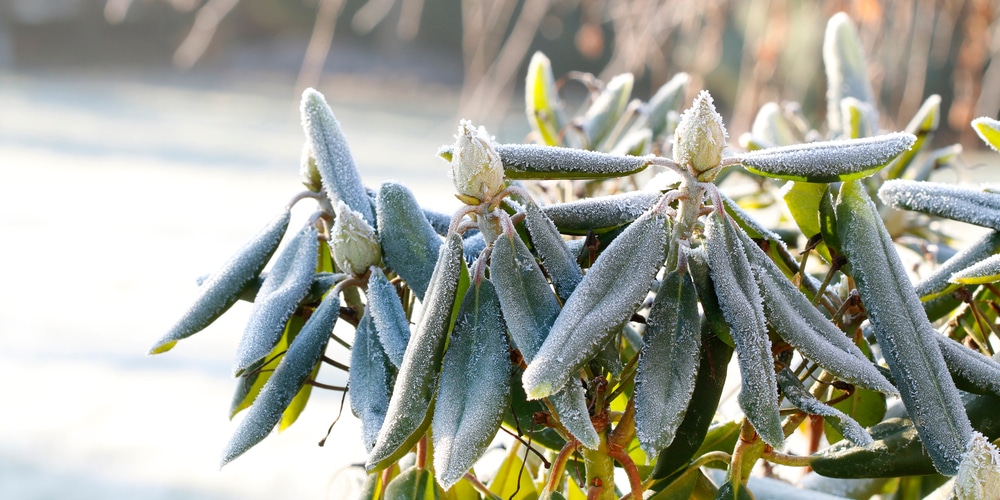Rhododendrons are among the most popular flowering shrubs, and it’s easy to see why. These evergreen shrubs are a welcome sight in any garden, showing off their large, showy blossoms. Prized for their beauty, rhododendrons are also relatively easy to care for.
Another distinct feature of rhododendrons is their ability to withstand lower temperatures than most other plants. In fact, many rhododendron varieties are native to mountainsides and cold climates. So, it’s no surprise that these tough shrubs can handle a little snow and ice.

Hardy in USDA zones 4 through eight, rhododendrons can easily survive cold winters. They can handle a bit of frost, but prolonged freezing temperatures can damage the plants. Even so, rhododendrons are relatively low-maintenance shrubs that require little care in winter.
Do Rhododendrons Lose Their Leaves During the Winter?
Winter is a time of year when the natural world slows down. The days grow shorter, and the cold air encourages plants to go into a state of dormancy. For many plants, this means shedding their leaves to conserve energy.
However, there are also evergreen plants that keep their leaves all year round. Rhododendrons are one type of evergreen known for their beautiful clusters of flowers. But do rhododendrons lose their leaves during the winter?
Depending on the variety, rhododendrons may keep their leaves throughout the winter months. Don’t be too concerned though, if you’ve noticed that your plant has started to lose some of its leaves. A few leaves wilting and dropping are normal and expected, especially if the plant is young.
However, in general, rhododendrons are tough plants that can withstand cold winters with ease. They have been considered mainstays in gardens for centuries, and their popularity is only increasing. Most of their leaves will remain vibrant and green, providing a welcome splash of color in the bleakest months.
These shrubs are a great addition to any garden, and their low-maintenance nature makes them even more appealing. So, if you’re looking for a plant that can brighten up your winter landscape, look no further than the trusty rhododendron.
How to Winter Rhodonderon
These hardy flowering shrubs known for their bright blossoms are actually relatively easy to take care of during the winter months.
To ensure that your rhododendron stays healthy throughout the winter, there are a few things you can do.
Keep the Soil Acidic
Acidity is vital for rhododendrons as it helps keep the soil moist and prevents the roots from drying out. If you live in an area with a high pH level, you may need to take measures to lower the pH of your soil.
One way to do this is by adding organic matter. It could be in the form of pine needles, compost, or peat moss.
Checking the soil pH level and making adjustments as necessary is one of the most important things you can do to care for your rhododendron in winter.
Watering
While it’s normal for a few leaves to drop once in a while, if you’ve noticed that most of your rhododendron’s leaves have wilted, it could be a sign that the plant isn’t getting enough water.
In general, rhododendrons need to be watered about once a week. However, they may need to be watered more often during the winter months. This is because the roots are less active, and the soil tends to dry out more quickly.
If you live in an area with a lot of snow, you may not need to water your rhododendron as often. The melting snow will provide the plant with the moisture it needs. Ensure that you have well-draining soil to prevent the roots from sitting in water.
Deadheading
Is it necessary to deadhead rhododendrons in the winter?
Yes, it’s actually a good idea to deadhead your rhododendron during the winter months. This will encourage new growth in the spring.
Gently remove the old flowers, careful not to damage the buds for next year. You can use pruning shears or your fingers to pinch off the dead blooms.
After removing the old flowers, give your plant a light trimming to shape it and encourage new growth.
Protect from Winter Frosts and Winds
Rhododendrons are tough plants, but they can still be damaged by harsh winter weather.
To protect your plant from frosts and winds, cover it with a piece of burlap or another type of breathable fabric. Ensure that the material is not touching the leaves, as this could cause damage.
You should also consider planting your rhododendron in a sheltered spot to protect it from strong winds.
Rhododendron in winter: Final Thoughts
Getting your hardy shrubs through the winter months is relatively easy if you take a few precautions. By following the tips above, you can ensure that your rhododendron stays healthy and blooms beautifully come springtime.
While a few wilted leaves are normal, if you notice that most of the leaves have wilted or fallen off, don’t forget to give your plant a good watering. And finally, don’t forget to deadhead and trim your rhododendron to encourage new growth in the spring.
